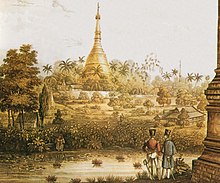The Shwedagon Pagoda (Burmese: ရွှေတိဂုံဘုရား; MLCTS: hrwe ti. gum bhu. ra:, IPA: [ʃwèdəɡòʊɰ̃ pʰəjá]); Mon: ကျာ်ဒဂုၚ်; officially named Shwedagon Zedi Daw (Burmese: ရွှေတိဂုံစေတီတော်, [ʃwèdəɡòʊɰ̃ zèdìdɔ̀], lit. 'Golden Dagon Pagoda') and also known as the Great Dagon Pagoda and the Golden Pagoda is a gilded stupa located in Yangon, Myanmar.
The Shwedagon is the most sacred Buddhist pagoda in Myanmar, as it is believed to contain relics of the four previous Buddhas of the present kalpa. These relics include the staff of Kakusandha, the water fil...Read more
The Shwedagon Pagoda (Burmese: ရွှေတိဂုံဘုရား; MLCTS: hrwe ti. gum bhu. ra:, IPA: [ʃwèdəɡòʊɰ̃ pʰəjá]); Mon: ကျာ်ဒဂုၚ်; officially named Shwedagon Zedi Daw (Burmese: ရွှေတိဂုံစေတီတော်, [ʃwèdəɡòʊɰ̃ zèdìdɔ̀], lit. 'Golden Dagon Pagoda') and also known as the Great Dagon Pagoda and the Golden Pagoda is a gilded stupa located in Yangon, Myanmar.
The Shwedagon is the most sacred Buddhist pagoda in Myanmar, as it is believed to contain relics of the four previous Buddhas of the present kalpa. These relics include the staff of Kakusandha, the water filter of Koṇāgamana, a piece of the robe of Kassapa, and eight strands of hair from the head of Gautama.
Built on the 51-metre (167 ft) high Singuttara Hill, the 112 m (367 ft) tall pagoda stands 170 m (560 ft) above sea level, and dominates the Yangon skyline. Yangon's zoning regulations, which cap the maximum height of buildings to 127 metres (417 feet) above sea level (75% of the pagoda's sea level height), ensure the Shwedagon's prominence in the city's skyline.
 View of the Great Dagon Pagoda in 1825, from a print after Lieutenant Joseph Moore of Her Majesty's 89th Regiment, published in a portfolio of 18 views in 1825–1826 lithography
View of the Great Dagon Pagoda in 1825, from a print after Lieutenant Joseph Moore of Her Majesty's 89th Regiment, published in a portfolio of 18 views in 1825–1826 lithography Scene upon the terrace of the Great Dagon Pagoda, 1824–1826
Scene upon the terrace of the Great Dagon Pagoda, 1824–1826 Shwedagon Pagoda in the 1890s
Shwedagon Pagoda in the 1890sLegend holds that the Shwedagon Pagoda was constructed more than 2,500 years ago — while the Buddha was still alive — which would make it the oldest Buddhist stupa in the world.[1] According to the Buddhavaṃsa, two merchants from Ukkalājanapada named Tapussa and Bhallika were passing through Bodh Gaya when they encountered the Buddha. The Buddha, who was at that time enjoying the bliss of his newly attained buddhahood as he sat under a rājāyatana tree, accepted their offering of rice cake and honey and taught them some of the dharma in return. In so doing, they became the first lay disciples to take refuge in the teachings of the Buddha.[2][3][4] The Buddha also gave eight strands of his hair to the merchants and gave them instructions on how to construct a stupa in which to enshrine these hair relics.[3] The merchants presented the eight strands of hair to King Okkalapa of Dagon, who enshrined the strands along with some relics of the three preceding Buddhas (Kakusandha, Koṇāgamana, and Kassapa) in a stupa on the Singuttara Hill in present-day Myanmar.[5]
The first mention of the pagoda in the royal chronicles dates only to 1362/63 CE (724 ME) when King Binnya U of Martaban–Hanthawaddy raised the pagoda to 18 m (59 ft). Contemporary inscriptional evidence, the Shwedagon Pagoda Inscriptions from the reign of King Dhammazedi of Hanthawaddy (r. 1471–1492), shows a list of repairs of the pagoda going back to 1436. In particular, Queen Shin Saw Pu (r. 1454–1471) raised its height to 40 m (130 ft), and gilded the new structure. By the beginning of the 16th century, Shwedagon Pagoda had become the most famous Buddhist pilgrimage site in Burma.[6]
A series of earthquakes during the following centuries caused damage. The worst damage was caused by a 1768 earthquake that brought down the top of the stupa, but King Hsinbyushin in 1775 raised it to its current height of 99 m (325 ft) (without counting the height of the hti (crown umbrella)). A new hti was donated by King Mindon in 1871, nearly two decades after the annexation of Lower Burma by the British. A moderate earthquake in October 1970 left the shaft of the hti out of alignment; extensive repairs were needed to rectify the problem.
The Shwedagon Pagoda Festival, which is the largest pagoda festival in the country, begins during the new moon of the month of Tabaung in the traditional Burmese calendar and continues until the full moon.[7] The pagoda is on the Yangon City Heritage List.































Add new comment